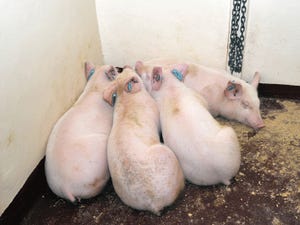What makes a feed facility a "biosecure facility?"
A ��“biosecure facility” is a facility that has adopted procedures to reduce the risk of pathogenic microbes being transmitted into or contaminating the final animal food product.
October 10, 2018

Source: Swine Health Information Center
With feed ingredient concerns increasing in the prevention of a potential foreign animal disease outbreak such as African swine fever, one word continues to come up ... biosecure. According to the National Pork Board, the National Pork Producers Council, the American Association of Swine Veterinarians and the Swine Health Information Center feedstuffs may be produced under biosecure, non-biosecure or unknown conditions. But what makes a feed facility a “biosecure facility?”
The American Feed Industry Association has developed a tentative working definition after consultation with AFIA members and pork industry representatives. This tentative working definition is provided for the animal food industry’s consideration as firms work with their suppliers on biosecurity, verification activities and to communicate such practices to customers.
A “biosecure facility” is a facility that has adopted procedures to reduce the risk of pathogenic microbes being transmitted into or contaminating the final animal food product. These procedures may vary depending on the animal food product produced, the disease status of the country or region where the facility is located, and where the facility’s ingredients are sourced. A facility should consider appropriate procedures as part of its biosecurity plan, including:
Mechanisms for evaluating suppliers for quality, safety and biosecurity, including verification that such programs are followed.
Designing and maintaining facilities to reduce and/or prevent the introduction of pathogenic microbes.
Adequate, routine housekeeping procedures to reduce and/or prevent the introduction of pathogenic microbes.
Standard Operating Procedures for biosecurity considerations in ingredient sourcing, receiving and storage.
Protocols for visitors, employees and drivers to control access to the facility, including maintaining proper hygiene.
Manufacturing practices that are effective/adequate in maintaining the facility’s biosecurity objectives.
Secure transportation of finished goods, including disinfection as appropriate, and the use of sealed containers.
The AFIA says while the pork organizations’ document represents their current thinking on minimum ingredient holding times, it should be noted that it is based on current, but limited, research. AFIA stands firm in its opinion that additional research in this area is necessary. As part of its crisis management team, AFIA has been working with its public charity, the Institute for Feed Education and Research, to look for opportunities to fund additional research.
The AFIA says it should also be noted that the pork organizations’ outline when mitigants should be applied “preshipping” from foreign countries. The AFIA cautions on the application and use of mitigants in imported feed or feed ingredients, as there are currently no approved mitigants for virus reduction. The effectiveness of mitigants is still unknown over the suggested duration of use or holding times, as well as the impact on product degradation.
The NPPC says while these current holding times have went through a review process along with the AFIA, ongoing work is being done to refine holding times and revisions and updates may be coming soon.
You May Also Like



